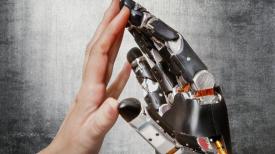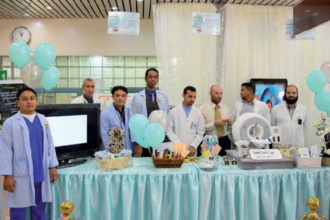 A team of scientists at the University of Chicago are working toward creating touch-sensitive prosthetic limbs that could someday convey sensory information to an amputee’s brain.
A team of scientists at the University of Chicago are working toward creating touch-sensitive prosthetic limbs that could someday convey sensory information to an amputee’s brain.
 A team of scientists at the University of Chicago are working toward creating touch-sensitive prosthetic limbs that could someday convey sensory information to an amputee’s brain. Their research has been funded in part by a multi-year Defense Advanced Research Projects Agency (DARPA) contract. To revolutionize prosthetics, the team is hoping to create an artificial limb that would reestablish a form of natural motor control by first restoring sensation to amputees.
A team of scientists at the University of Chicago are working toward creating touch-sensitive prosthetic limbs that could someday convey sensory information to an amputee’s brain. Their research has been funded in part by a multi-year Defense Advanced Research Projects Agency (DARPA) contract. To revolutionize prosthetics, the team is hoping to create an artificial limb that would reestablish a form of natural motor control by first restoring sensation to amputees.
“If you lose your somatosensory system it almost looks like your motor system is impaired,” the study’s senior author, Sliman Bensmaia, Ph.D., assistant professor at the University of Chicago, stated in a press release. “If you really want to create an arm that can actually be used dexterously without the enormous amount of concentration it takes without sensory feedback, you need to restore the somatosensory feedback.”
Somatosensory feedback is what allows the fingertips to understand how hard the hand is squeezing something or where an object is positioned relative to the hand. Although a contemporary prosthetic allows an amputee to grasp an object, similar to the way an arcade crane permits a person to grasp a stuffed ball, the amount of concentration necessary to do so is considerable. In essence, the sense of vision must compensate for a lack of the sense of touch.
Progressing Research
For a study published this past May, Bensmaia and his team worked on understanding how an organism might be able to sense a tactile stimulus, in real time, through an artificial sensor. After identifying the patterns of neural activity sparked by touch, they created an equation to mimic the electrical pulse that accompanies the sensation of touch. Then, they created a prosthetic hand wired to brain implants in an experiment with rhesus macaques, whose sensory systems closely resemble those of humans. Each time they touched the prosthetic hand with a physical probe, electrical signals were sent to the brain.
“We think the key is to invoke what we know about how the brain of the intact organism processes sensory information, and then try to reproduce these patterns of neural activity through stimulation of the brain,” Bensmaia stated in a press release.
“To restore sensory motor function of an arm, you not only have to replace the motor signals that the brain sends to the arm to move it around, but you also have to replace the sensory signals that the arm sends back to the brain,” Bensmaia stated in a press release.
Restoration of the Self
Currently, Bensmaia and his team await Food and Drug Administration approval of similar devices for human trials, which they hope can begin within the next year. Because they have never produced true sensations, prosthetics and robotic arms have always felt more like tools![]() than real replacements. According to the Limbs for Life Foundation, more than 150,000 individuals join over four million existing amputees in the U.S. each year. The primary causes of limb loss are disease, most notably diabetes, accidents, birth defects, and warfare.
than real replacements. According to the Limbs for Life Foundation, more than 150,000 individuals join over four million existing amputees in the U.S. each year. The primary causes of limb loss are disease, most notably diabetes, accidents, birth defects, and warfare.
Amputees face not only staggering emotional and lifestyle challenges but also — in many cases — financial difficulties if they cannot work. If a prosthetic limb could produce a lifelike sense of touch, this would not only improve dexterity but also help amputees regain the all-important sense of self.
“If every time you see your robotic arm touching something, you get a sensation that is projected to it, I think it’s very possible that in fact, you will consider this new thing as being part of your body,” Bensmaia stated in a press release.
Sources: Berg JA, Dammann JF, Bensmaia S, et al. Behavioral Demonstration of a Somatosensory Neuroprosthesis. IEEE. 2013.
Bensmaia S, Tabot G, Dammann J, et al. Spatial and temporal codes mediate the tactile perception of natural textures. Proceedings of the National Academy of Sciences. 2013.
(image: PNAS, 2013)








